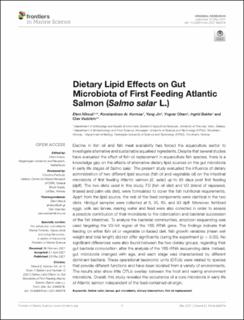| dc.contributor.author | Eleni, Nikouli | |
| dc.contributor.author | Konstantinos Ar., Kormas | |
| dc.contributor.author | Yang, Jin | |
| dc.contributor.author | Olsen, Yngvar | |
| dc.contributor.author | Bakke, Ingrid | |
| dc.contributor.author | Vadstein, Olav | |
| dc.date.accessioned | 2021-05-26T08:56:38Z | |
| dc.date.available | 2021-05-26T08:56:38Z | |
| dc.date.created | 2021-05-21T12:05:43Z | |
| dc.date.issued | 2021 | |
| dc.identifier.citation | Frontiers in Marine Science. 2021, 8, . | en_US |
| dc.identifier.issn | 2296-7745 | |
| dc.identifier.uri | https://hdl.handle.net/11250/2756398 | |
| dc.description.abstract | Decline in fish oil and fish meal availability has forced the aquaculture sector to investigate alternative and sustainable aquafeed ingredients. Despite that several studies have evaluated the effect of fish oil replacement in aquaculture fish species, there is a knowledge gap on the effects of alternative dietary lipid sources on the gut microbiota in early life stages of Salmo salar. The present study evaluated the influence of dietary administration of two different lipid sources (fish oil and vegetable oil) on the intestinal microbiota of first feeding Atlantic salmon (S. salar) up to 93 days post first feeding (dpff). The two diets used in this study, FD (fish oil diet) and VD (blend of rapeseed, linseed and palm oils diet), were formulated to cover the fish nutritional requirements. Apart from the lipid source, the rest of the feed components were identical in the two diets. Hindgut samples were collected at 0, 35, 65, and 93 dpff. Moreover, fertilized eggs, yolk sac larvae, rearing water and feed were also collected in order to assess a possible contribution of their microbiota to the colonization and bacterial succession of the fish intestines. To analyze the bacterial communities, amplicon sequencing was used targeting the V3–V4 region of the 16S rRNA gene. The findings indicate that feeding on either fish oil or vegetable oil-based diet, fish growth variables (mean wet weight and total length) did not differ significantly during the experiment (p > 0.05). No significant differences were also found between the two dietary groups, regarding their gut bacteria composition, after the analysis of the 16S rRNA sequencing data. Instead, gut microbiota changed with age, and each stage was characterized by different dominant bacteria. These operational taxonomic units (OTUs) were related to species that provide different functions and have been isolated from a variety of environments. The results also show little OTUs overlap between the host and rearing environment microbiota. Overall, this study revealed the occurrence of a core microbiota in early life of Atlantic salmon independent of the feed-contained oil origin. | en_US |
| dc.language.iso | eng | en_US |
| dc.publisher | Frontiers Media | en_US |
| dc.rights | Navngivelse 4.0 Internasjonal | * |
| dc.rights.uri | http://creativecommons.org/licenses/by/4.0/deed.no | * |
| dc.title | Dietary Lipid Effects on Gut Microbiota of First Feeding Atlantic Salmon (Salmo salar L.) | en_US |
| dc.type | Peer reviewed | en_US |
| dc.type | Journal article | en_US |
| dc.description.version | publishedVersion | en_US |
| dc.source.volume | 8 | en_US |
| dc.source.journal | Frontiers in Marine Science | en_US |
| dc.identifier.doi | 10.3389/fmars.2021.665576 | |
| dc.identifier.cristin | 1911294 | |
| dc.description.localcode | Copyright © 2021 Nikouli, Kormas, Jin, Olsen, Bakke and Vadstein. This is an open-access article distributed under the terms of the Creative Commons Attribution License (CC BY). The use, distribution or reproduction in other forums is permitted, provided the original author(s) and the copyright owner(s) are credited and that the original publication in this journal is cited, in accordance with accepted academic practice. No use, distribution or reproduction is permitted which does not comply with these terms. | en_US |
| dc.source.articlenumber | 665576 | en_US |
| cristin.ispublished | true | |
| cristin.fulltext | original | |
| cristin.qualitycode | 1 | |

